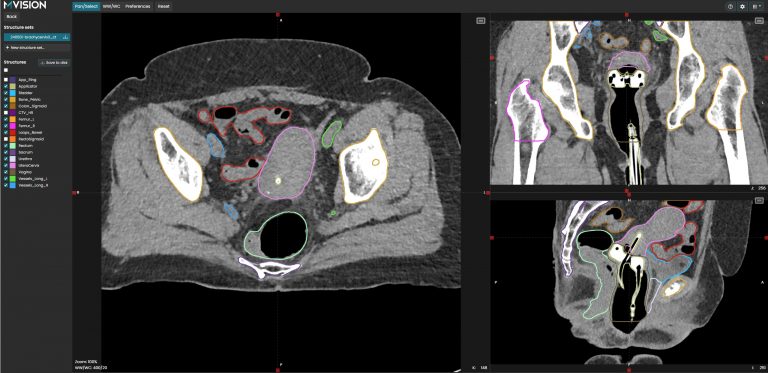January is Cervical Cancer Awareness Month, and these three core principles are emphasized during the 2024 campaign. Nowadays, cervical cancer is responsible for more than 300,000 deaths each year globally. Fortunately, we have the tools to prevent it, diagnose it early, and treat it efficiently in most cases. This is why we need to become aware, stay alert, and take the necessary measures, as individuals and nations. MVision AI supports Radiation Oncology professionals in delivering efficient treatments for patients fighting cervical cancer.
Why is it important to be aware of cervical cancer?
- Because it is diagnosed in more than 600,000 women and is the cause of losing more than 300,000 lives each year globally (1).
- Because it is preventable. Persistent HPV infection is present in 99.7% of cervical cancer cases (2), and HPV vaccination decreases the incidence of new cases (3,4). Fortunately, 140 countries have already implemented HPV vaccination in their national immunization programs. Norway reported that there was no case of HPV-related cervical cancer among the first cohort of women who were offered vaccination as children (5).
- Because when diagnosed in the early stages, the survival rate at 5 years is 80-90%, while for metastatic cases, it is only about 15% (6). Screening increases the chance of early detection and, therefore, of curing the patients (7).
Why is radiation therapy relevant for cervical cancer?
- For the majority of patients diagnosed in localized stages, the combination of radiation therapy and chemotherapy is the primary treatment option.
- In cases with metastatic disease, radiation therapy still plays an important role for selected patients (8).
How does MVision AI support cervical cancer patients?
If cervical cancer is diagnosed, patients need to start a personalized treatment – ideally, as soon as possible. When MVision AI Contour+ female pelvis mode is used as a starting point, the radiation therapy teams can provide a highly adapted treatment plan which is created faster compared with manual delineation (9-10). This comprehensive model offers a total of 49 structures, including 41 organs at risk and anatomical landmarks, 3 CTVs and 5 lymph nodes regions. We believe that for offering a quality treatment, guideline-based auto-contouring developed using AI is the new “must have” that increases productivity and consistency.
References
- Cervical cancer awareness month. https://www.tn.gov/content/dam/tn/health/program-areas/Cervical-Cancer-Awareness-Month-Toolkit-2024.pdf
- Okunade KS. Human papillomavirus and cervical cancer [published correction appears in J Obstet Gynaecol. 2020 May;40(4):590]. J Obstet Gynaecol. 2020;40(5):602-608. doi:10.1080/01443615.2019.1634030
- Kjaer SK, Dehlendorff C, Belmonte F, Baandrup L. Real-World Effectiveness of Human Papillomavirus Vaccination Against Cervical Cancer. J Natl Cancer Inst. 2021;113(10):1329-1335. doi:10.1093/jnci/djab080
- Ren X, Hao Y, Wu B, et al. Efficacy of prophylactic human papillomavirus vaccines on cervical cancer among the Asian population: A meta-analysis. Front Microbiol. 2022;13:1052324. Published 2022 Dec 2. doi:10.3389/fmicb.2022.1052324
- Global partners cheer progress towards eliminating cervical cancer and underline challenges. https://www.who.int/news/item/17-11-2023-global-partners-cheer-progress-towards-eliminating-cervical-cancer-and-underline-challenges
- Canadian Cancer Society – Cervical cancer facts. https://cancer.ca/en/cancer-information/cancer-types/cervical/prognosis-and-survival/survival-statistics
- Landy R, Sasieni PD, Mathews C, et al. Impact of screening on cervical cancer incidence: A population-based case-control study in the United States. Int J Cancer. 2020;147(3):887-896. doi:10.1002/ijc.32826
- NCCN gGuidelines Cervical cancer. https://www.nccn.org/professionals/physician_gls/pdf/cervical_blocks.pdf
- B. Bordigoni, et al MO-03.9 – COMPREHENSIVE COMPARISON OF FOUR AUTOMATIC TOOLS IN OAR SEGMENTATION FOR GYNAECOLOGICAL RADIOTHERAPY, Physica Medica, Volume 115, Supplement 1, 2023, 102806, ISSN 1120-1797,https://doi.org/10.1016/j.ejmp.2023.102806.
- https://it-posters.com/seor2022/poster/view?id=895



